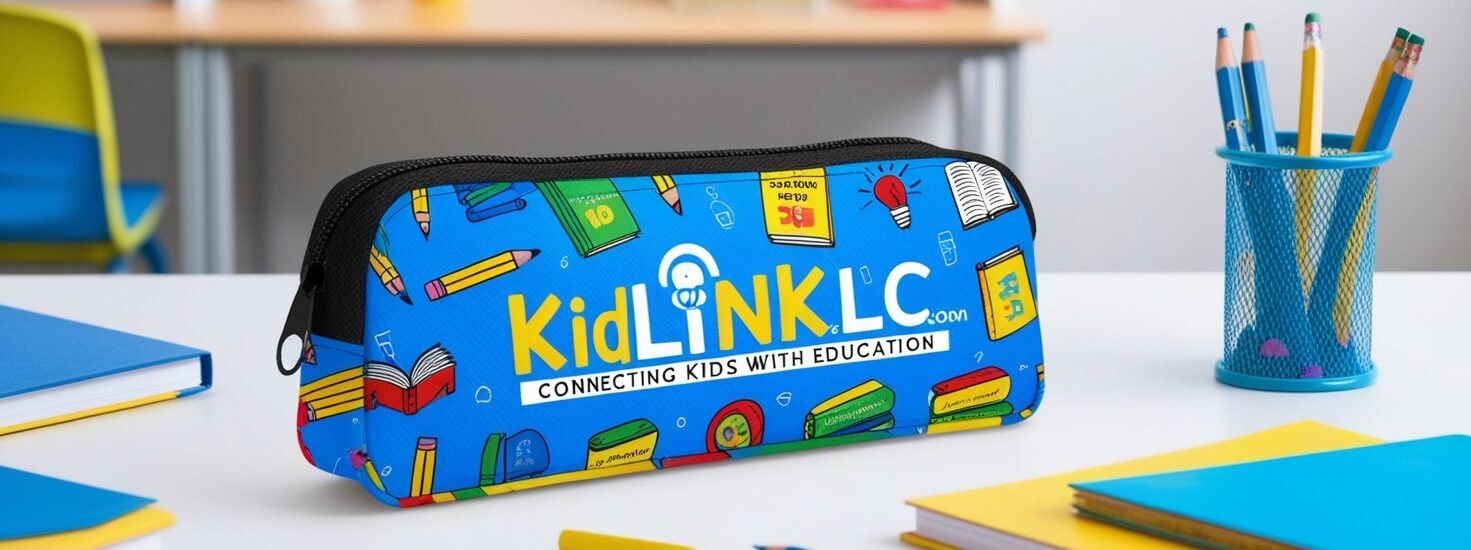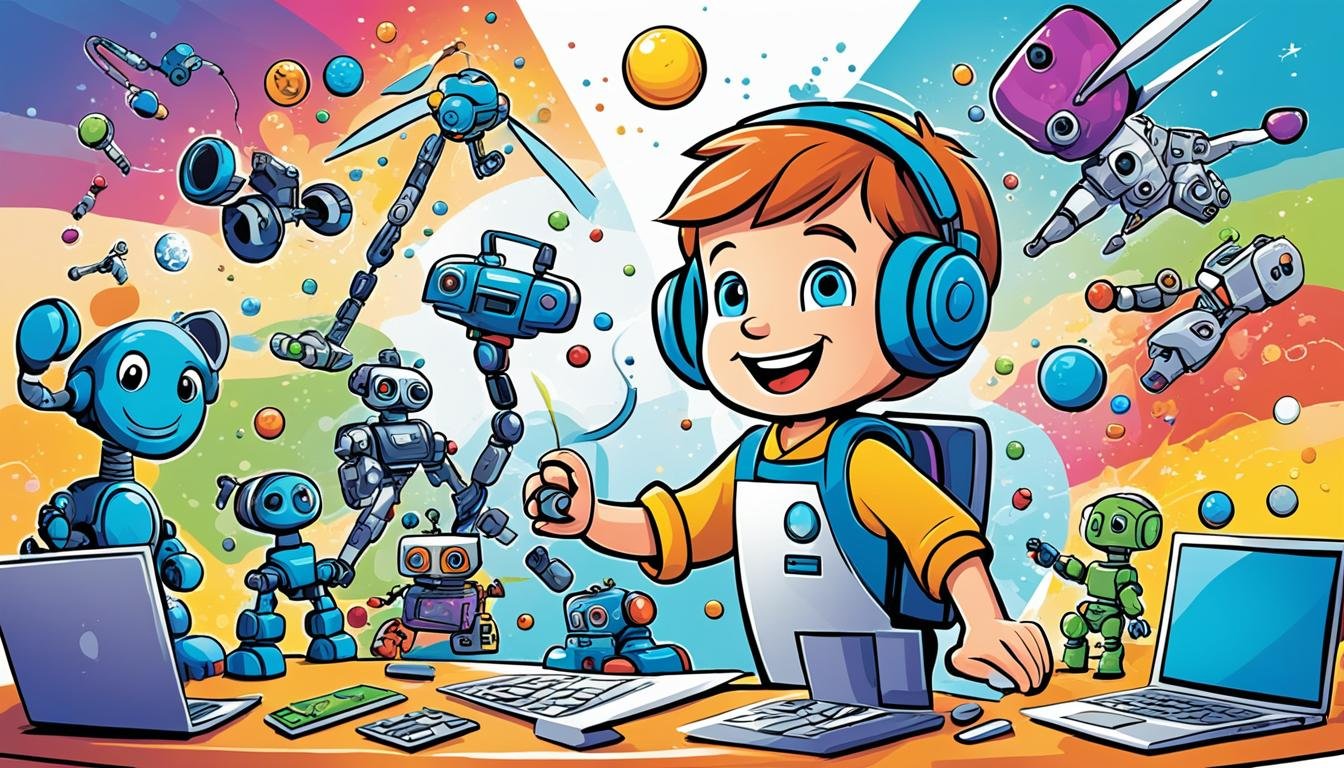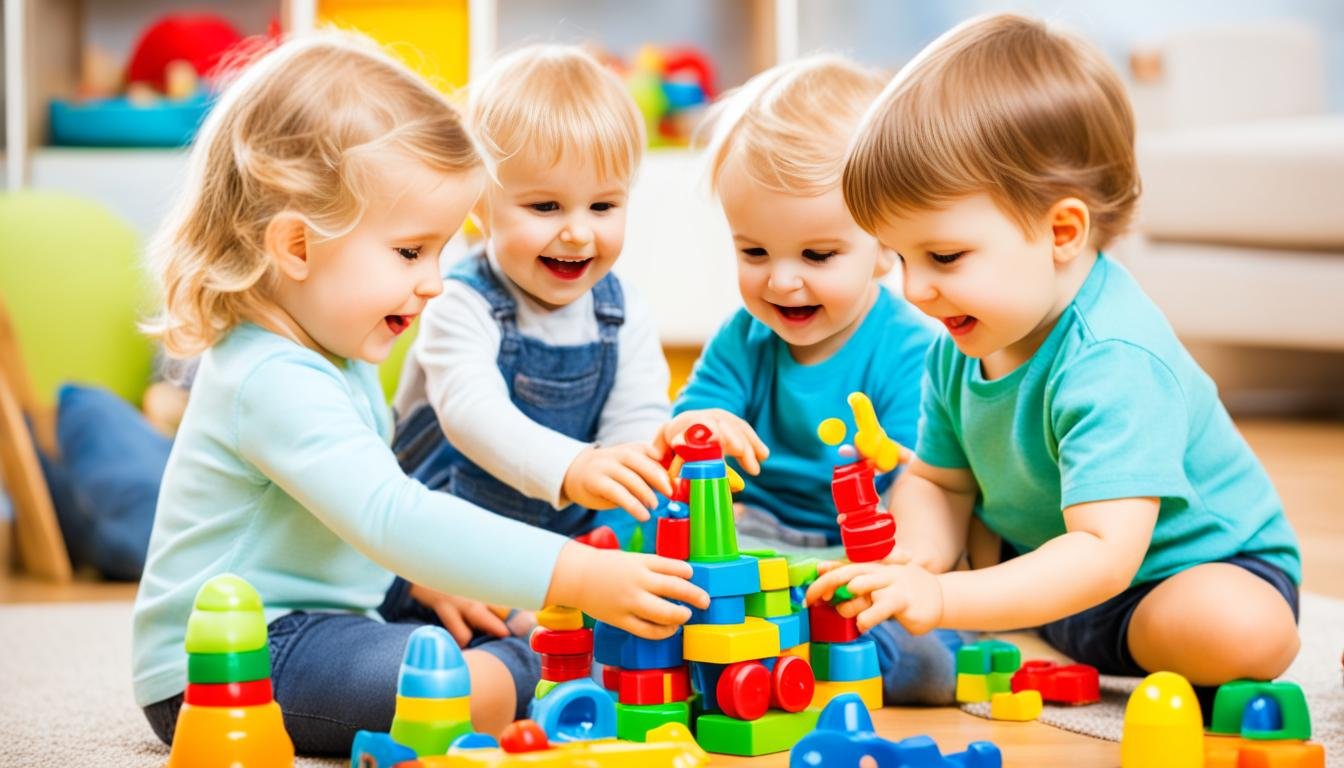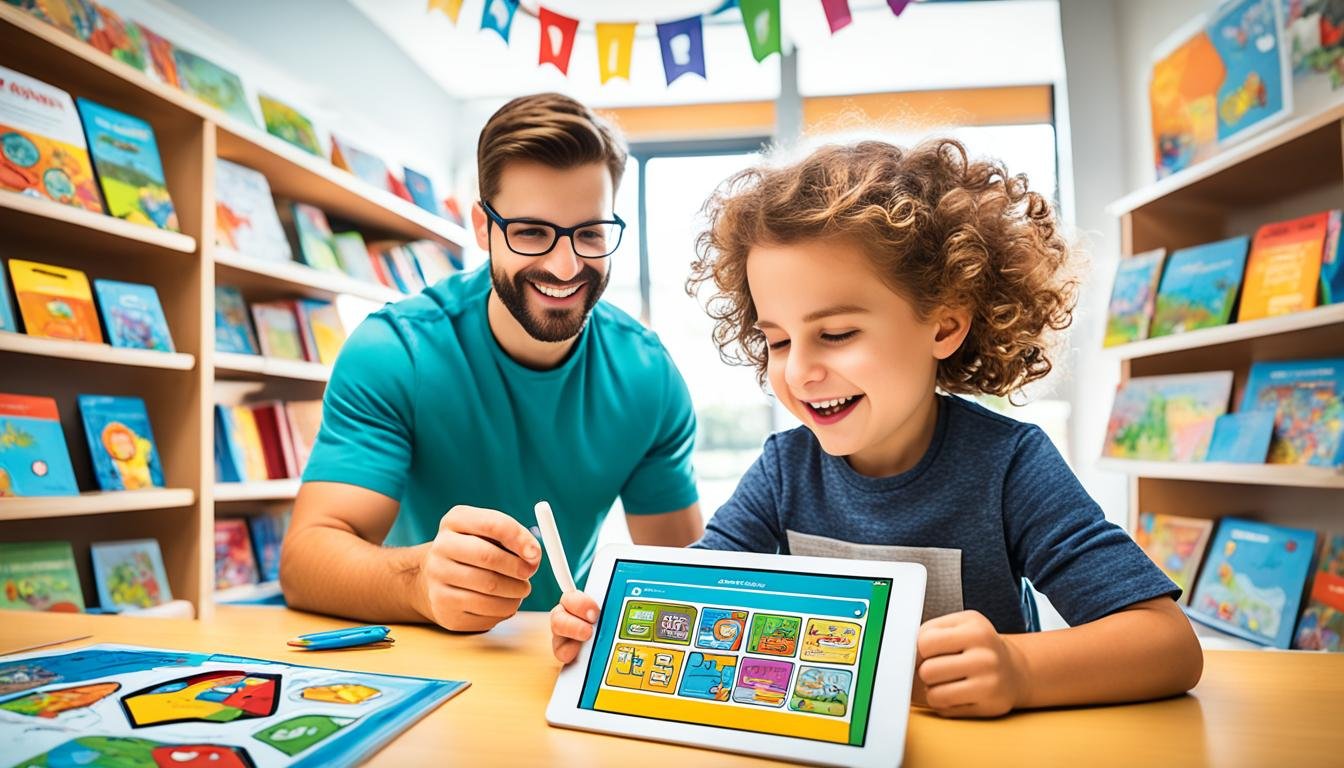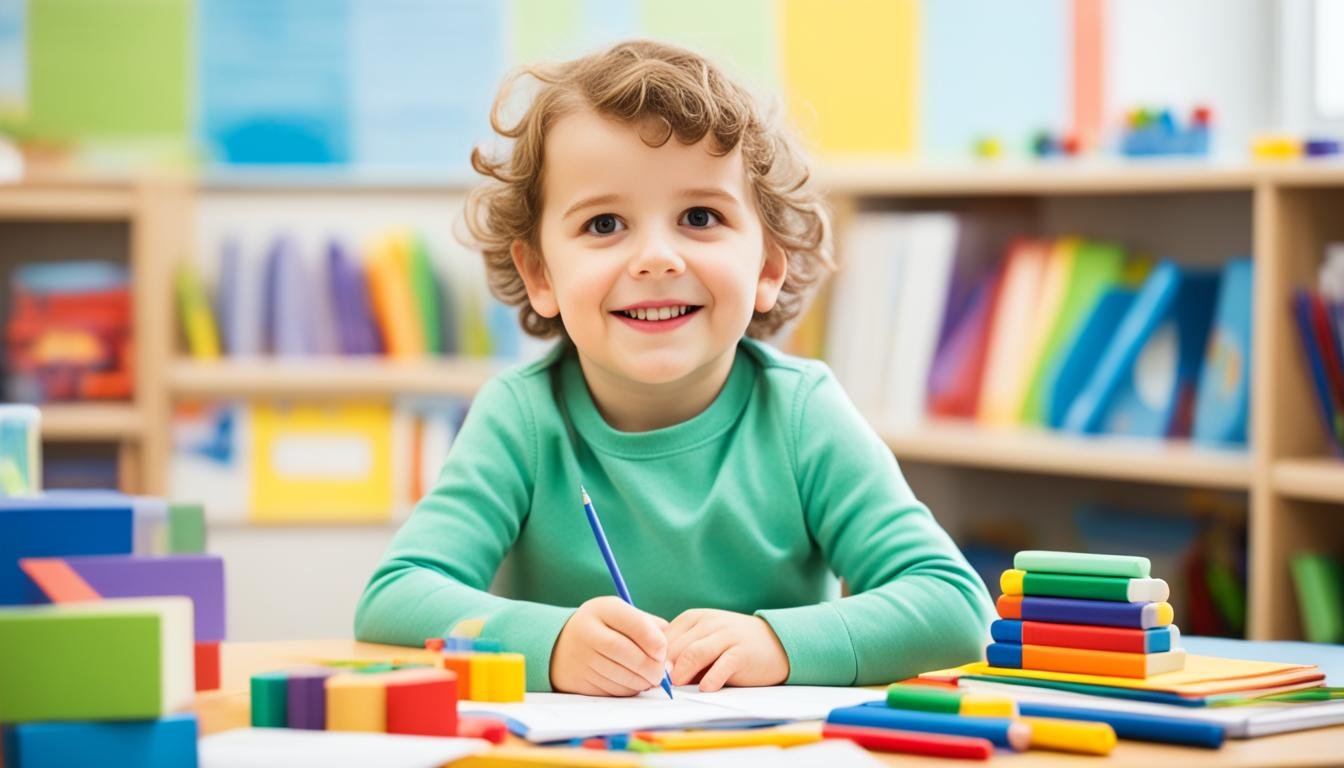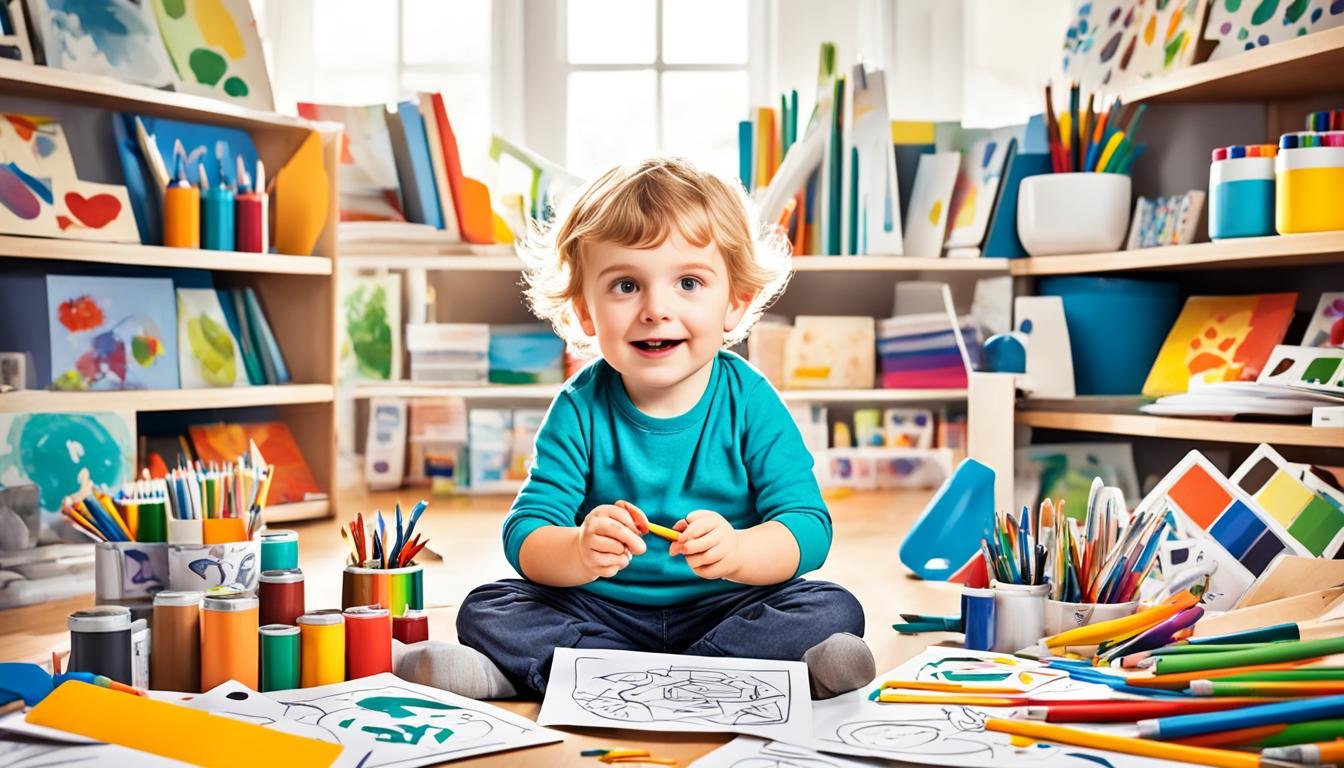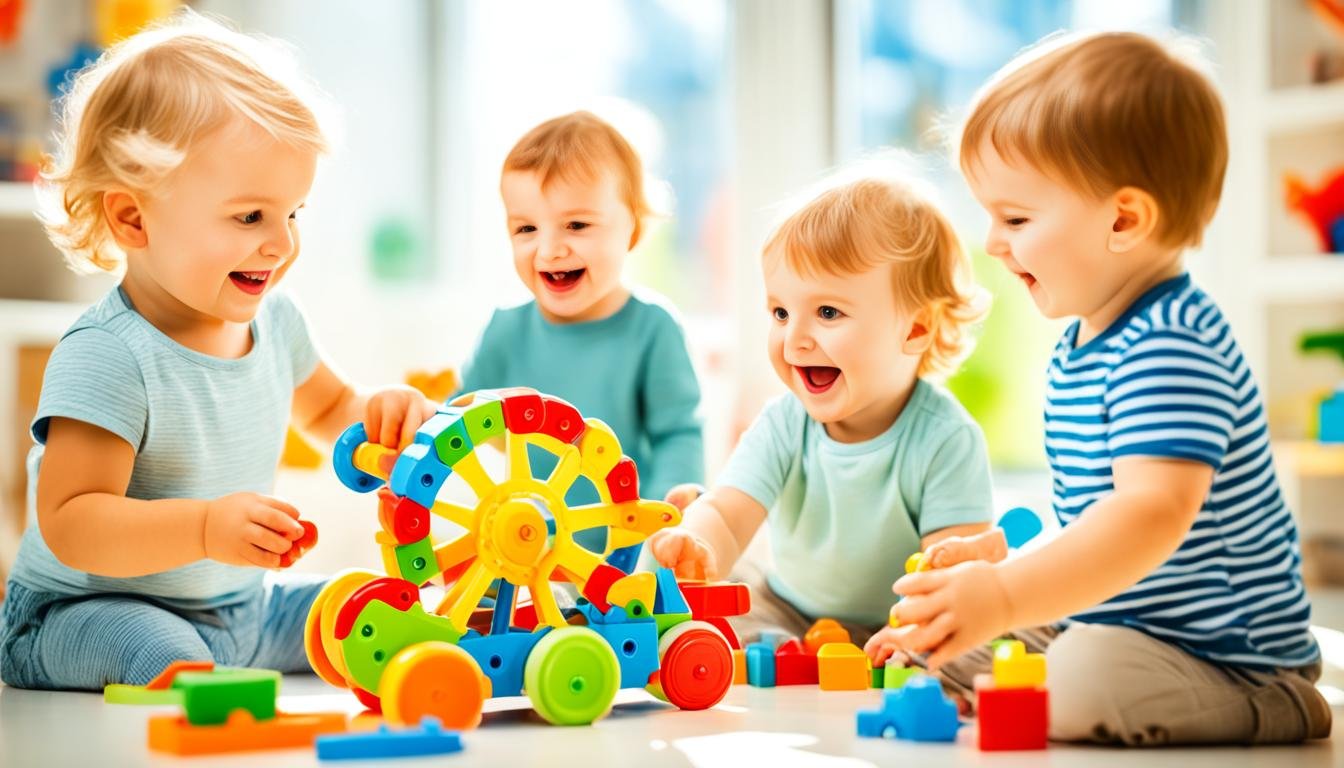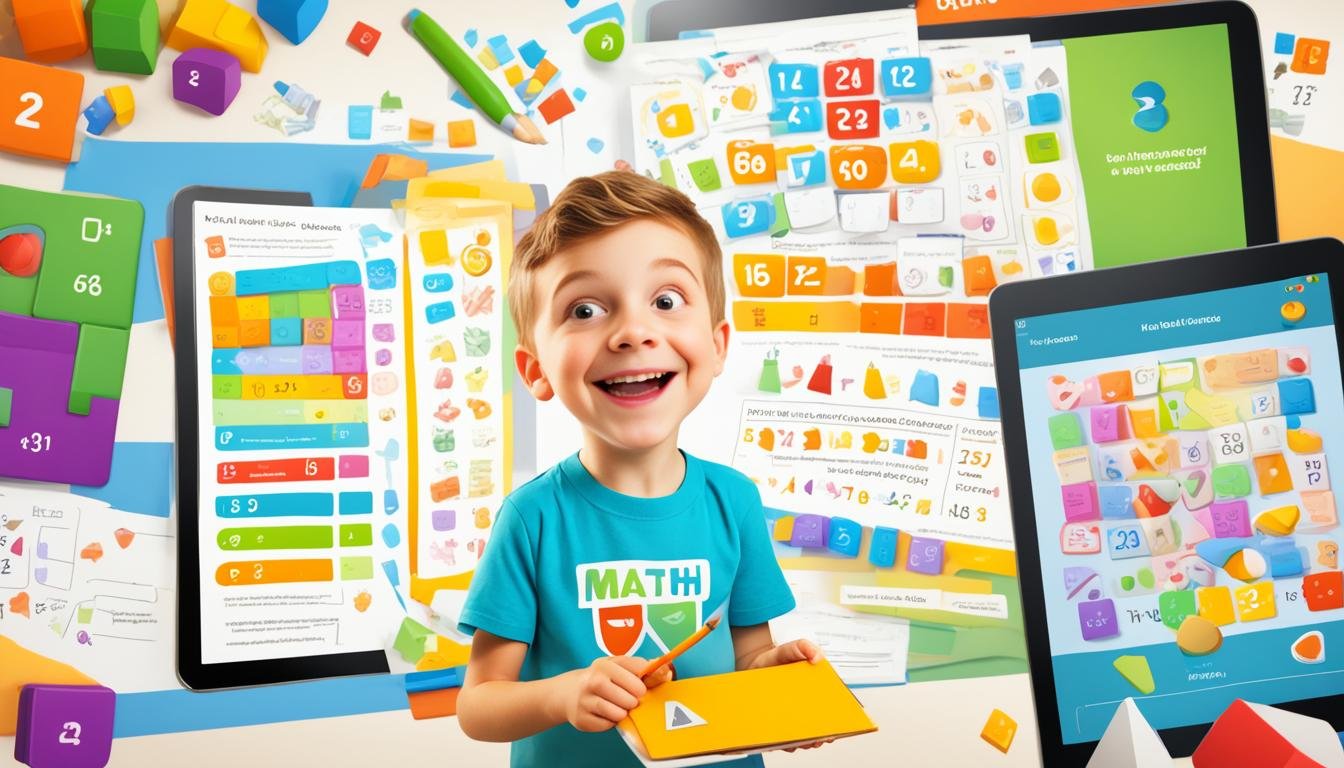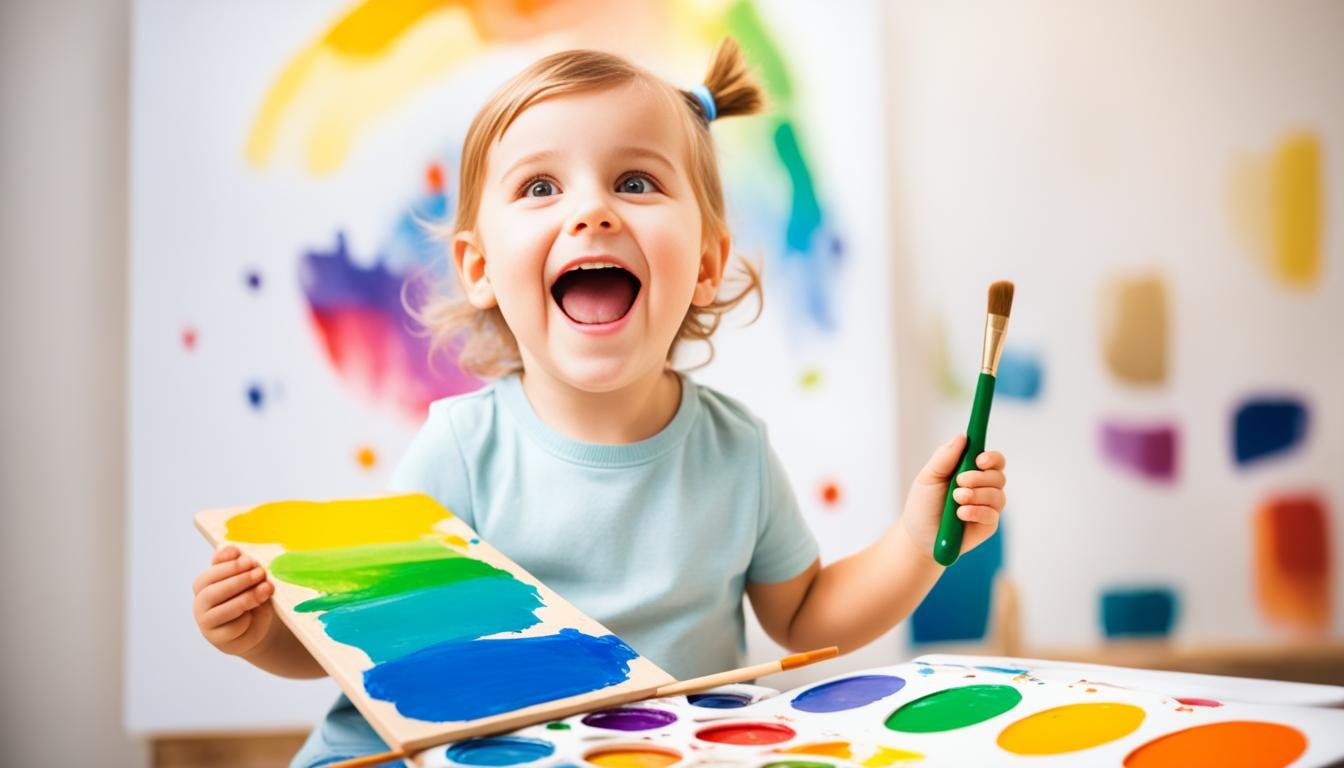Have you ever thought about why some kids handle their feelings better than others? Learning how to manage emotions is key to their happiness and health. We’ll look at how emotional intelligence starts in childhood and how we can help. By teaching them to control their feelings from a young age, we set them up for a lifetime of emotional health.
Key Takeaways
- Emotional intelligence is a vital aspect of childhood development.
- Teaching children to manage emotions requires active parental involvement.
- Understanding each child’s emotional development stage is crucial.
- Early interventions significantly impact long-term emotional regulation.
- Secure attachment fosters emotional well-being and resilience.
- Modeling emotional regulation helps children learn effectively.
- Creating safe spaces to talk about emotions promotes openness.
The Importance of Emotional Intelligence in Children
In today’s world, kids’ emotional intelligence is key to their growth. It helps them understand and manage their feelings. This is crucial for their emotional health. Studies show that teaching emotional skills helps kids do better in school and make friends.
When kids learn to recognize and express their feelings, they can tackle challenges better. Educational tools that teach emotional literacy help a lot. Teaching emotional intelligence skills, like labeling and controlling emotions, makes a supportive space for kids to grow emotionally.
Kids with high emotional intelligence do well in social situations and do better in school. They can understand their feelings and connect with others, building stronger friendships. These skills also make schools and homes healthier, improving children’s emotional well-being.
We can learn a lot from educational sites that focus on emotional learning. For example, KidLinkLC.com has resources that teach kids about emotions. By giving kids these tools, parents and teachers can help them feel emotionally well.
| Benefits of Emotional Intelligence | Impact on Learning | Social Development |
|---|---|---|
| Better emotion regulation | Improved academic performance | Stronger relationships |
| Enhanced empathy | Increased engagement in school | Effective communication skills |
| Positive behavior management | Heightened readiness to learn | Healthier interactions |
Seeing how important emotional intelligence is helps us create a caring place for our kids. By teaching these skills, we boost their personal success and help build a more caring, emotionally aware community.
Understanding Emotional Development Stages
Childhood emotional growth is key to their overall development. It starts from birth and goes through different stages. Babies show feelings through crying and body language. This is the first step in understanding emotions.
By the time they are two to three years old, kids start to name their feelings. This makes them more aware of their emotions. This awareness is important for their emotional growth.
Between the ages of three to five, kids get better at handling their feelings. They learn to recognize and deal with emotions like frustration and anxiety. It’s important to create a safe space for them to express these feelings.

Knowing these stages helps us support our children emotionally. We can guide them through emotions like fear. Helping them manage their feelings helps them deal with life’s challenges.
For more information, check out a detailed guide on emotional development here.
Building a strong emotional base has long-term benefits. It helps with self-awareness and social skills. As caregivers, we play a big role in teaching kids about emotions. Talking openly about feelings helps build important skills.
For more resources, see the terms of use for educational content here. It highlights the value of respecting emotional growth.
| Age Range | Key Emotional Development Features | Caregiver Support Strategies |
|---|---|---|
| 0-1 Year | Crying, body language, basic emotions | Provide a comforting environment |
| 2-3 Years | Recognizing and labeling emotions | Encourage expression of feelings |
| 3-5 Years | Managing complex emotions | Teach coping strategies and emotional vocabulary |
Teach Children to Manage Emotions Through Early Interventions
Teaching kids about emotions early helps them manage their feelings better. We can start with simple feelings when they begin to show them. By showing them how to handle emotions and talking about them when calm, kids learn to control their feelings.
At different ages, we can use various ways to help kids with their feelings. For young children, playing games helps them understand and share their feelings. As they get older, talking about feelings helps them grasp more complex emotions and how to deal with them.
It’s important to know when a child needs extra help. Getting support early can stop emotional problems later, as shown in this article about managing emotions in children. We should start teaching them about emotions early and help them along the way.
Showing kids that their feelings are important and can be handled helps them for the future. Looking at how we handle our feelings also helps us teach our kids better. This way, we pass on good ways to deal with emotions to the next generation.
Talking openly about feelings helps kids use better coping strategies and builds a caring environment. This helps them become stronger and better at handling life’s ups and downs.
For more on understanding and managing emotions, check out more info at this link.
Building a Secure Attachment with Your Child
Creating a strong bond with our kids is key for their emotional growth. A secure attachment means they feel safe and supported. This helps them share their feelings and handle stress better.
Building this bond takes effort from us parents. We should meet our child’s emotional needs quickly. This makes them trust us more and helps their mental health. By being there for them in tough times, we make them feel secure.
- Engaging in quality time to strengthen our relationship.
- Listening actively to our children’s thoughts and emotions.
- Providing comfort and reassurance during difficult moments.
- Encouraging expression of feelings without judgment.
These tips show how important we are in creating a caring space. By building a secure attachment, we help our kids do well emotionally. They’ll face life’s challenges better.

Modeling Emotional Regulation as Parents
We know how important we are in helping our kids handle their feelings. As parents, we set the example for how they will deal with emotions later on. When we stay calm when things get tough, we show them how to manage their feelings in a healthy way.
How we act with our emotions helps teach our kids to control theirs. By talking about our feelings, we make it safe for them to share theirs too. This helps them feel okay with expressing what they’re going through.
- Demonstrating calmness in stressful situations.
- Expressing our emotions verbally, such as saying “I feel frustrated” or “I am sad.”
- Sharing strategies we use for emotional regulation, like taking a deep breath or counting to ten.
By doing these things, we show our kids that it’s okay to feel and deal with emotions. Our actions show them that they can handle their feelings too. Kids learn by watching us handle our emotions in everyday life.
Talking About Emotions in Calmer Moments
We can help kids understand their feelings by talking about them when things are calm. This way, we can have deep talks without the stress of strong emotions. By doing this, we help our kids learn to share their feelings clearly.
Storybooks, everyday life, and movies are great ways to start these talks. For example, talking about a character’s feelings can teach empathy and how to solve problems. These stories help our kids see how others feel and how they can feel too.
Using these strategies for kids’ emotional wellbeing gives our kids the skills they need for the future. Regular chats help them understand and handle their feelings better. By making these talks a priority, we teach our kids empathy and build stronger emotional bonds with them.
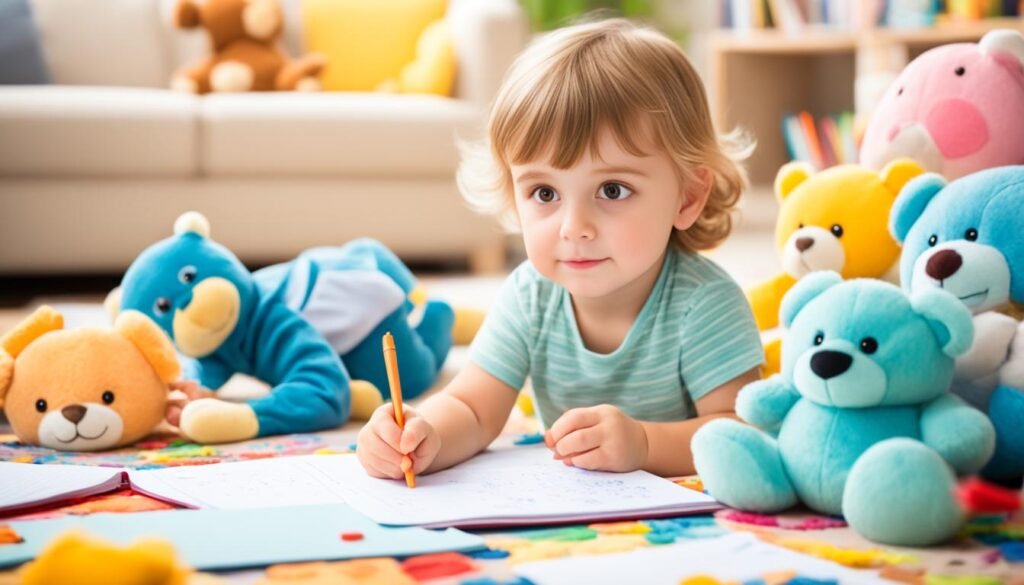
Using Play to Enhance Emotional Awareness
Play is key for kids to learn about their feelings. Emotional literacy activities for children let them safely explore and share their emotions. Through play, they can act out different feelings, helping them understand and talk about their emotions.
Play also helps kids get better at social skills. We can play games that make them work together. This lets them talk about their feelings and understand each other better. It’s a great way to help them share and manage their emotions.
- Role-playing different scenarios to help children express their feelings.
- Participating in cooperative games that require communication and teamwork.
- Introducing storytelling to facilitate discussions around emotions.
These methods help kids control their feelings and deal with tough emotions as they get older. Giving kids chances to learn through play is key for their emotional growth.
| Activity Type | Benefits |
|---|---|
| Imaginative Play | Encourages expression of emotions and builds empathy. |
| Cooperative Games | Fosters communication and team-building skills. |
| Storytelling | Enhances understanding of emotions through narrative. |
Using these play strategies helps kids become more aware of their feelings. It gives them the skills they need to manage their emotions well in the future.
Strategies to Encourage Children to Identify Emotions
It’s key for our kids to know and show their feelings. We can use strategies for teaching emotions to kids. Tools like emotion cards are simple yet powerful. They show feelings like happiness, sadness, anger, and surprise, helping kids connect with their own feelings.
Creating scenarios for emotional talks is another way to help. By asking about a story character’s feelings, we make kids think deeply about emotions. This helps them help kids express emotions and understand others better.
Doing these emotional awareness techniques often makes kids better at it. By making emotional learning a part of daily life, we make a safe space for them to share their feelings. We aim to make these strategies a regular part of our kids’ lives, teaching them the value of emotional smarts.
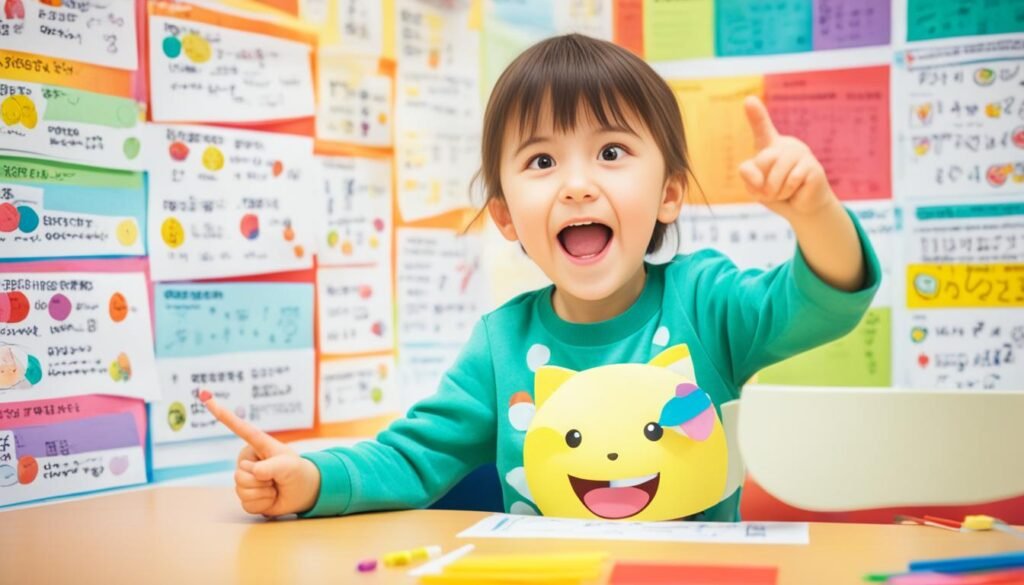
Ways to Validate Your Child’s Emotions
Validating emotions for children is key to supporting their feelings and helping them manage their emotions. It’s important to tell them that every feeling is okay and deserves to be heard. When a child feels upset or frustrated, it’s crucial to show understanding and care.
Actions like mirroring their feelings, using kind words, and creating a safe space for talks help a lot. This makes them feel understood and valued.
We’re not just ignoring their feelings. We’re working to help them become more emotionally strong. Recognizing their feelings helps them see themselves in a positive light and feel they belong. By validating our children’s emotions, we make them feel important and heard.
- Listen actively when your child shares their feelings.
- Acknowledge their emotions by reflecting back what you hear.
- Encourage conversations about their feelings without judgment.
- Use phrases like “It’s okay to feel sad” or “I understand you’re frustrated.”
- Share personal experiences that relate to their feelings.
Helping Children Cope with Feelings Through Role Play
Role play is a great way to help kids deal with their emotions. It lets them safely explore and understand their feelings through pretend scenarios. This method helps them learn how to handle different emotional situations.
During role play, we create a safe space for kids to try out different emotional responses. It helps them feel more confident when facing real-life challenges. For example, acting out a conflict with a friend teaches them how to express feelings, listen, and solve problems.
Role play also helps kids develop empathy and understand others’ feelings. By taking on different roles, they learn to see things from another person’s point of view. This is key to emotional intelligence.

Adding role play to our daily lives can really boost our kids’ emotional health. We can use themes that match their current experiences or challenges. This hands-on approach gives them the skills they need to manage their emotions better.
Promoting Coping Skills for Kids
Teaching our children how to handle their feelings is key to their emotional health. By showing them ways to deal with stress and anxiety, we help them manage their emotions better. Simple actions like deep breathing, counting to ten, or drawing can really help.
We should help our kids know when they’re feeling too much. When they tell us how they feel, we can show them ways to cope. For example, we might suggest they take a break and breathe deeply. This can help them control their feelings better.
Adding these activities into our daily life helps our kids learn to manage their emotions. Talking about feelings often makes them feel secure in sharing theirs. By giving them these coping skills, we make sure they can deal with their feelings on their own.

How to Guide Children in Problem-Solving Emotional Challenges
Helping kids deal with their feelings is key to their growth. We should work on improving their problem-solving skills. This means helping them understand and manage their emotions better.
Talking openly about feelings helps kids grow emotionally. We start by celebrating when they share their feelings. For example, if a child feels upset after losing a game, we talk about how to handle disappointment.

Teaching kids to handle their feelings takes time and effort. Here are some ways to help:
- Encourage Reflection: Ask them, “What made you feel this way?” This helps them think deeply about their feelings.
- Offer Solutions: Help them come up with ways to deal with their feelings. This gives them power and teaches them to manage their emotions.
- Create a Safe Space: Make sure kids feel safe when they talk about their feelings. A safe space leads to honest conversations.
We should guide them by showing how to handle emotions in a healthy way. We also need to teach them about bouncing back from tough times. For more tips on supporting kids with their feelings, check out this detailed resource. Working together and setting realistic goals helps build a strong emotional base for our kids.
Utilizing Praise and Positive Reinforcement
Positive reinforcement is key for kids’ emotional growth. When we praise their efforts in handling emotions, they feel seen and valued. This method moves us from focusing on what’s wrong to celebrating their progress.
Using praise helps kids understand and control their feelings. We can use different ways to help, such as:
- Offering specific compliments when they show their feelings well.
- Supporting their efforts to control their emotions, even if they don’t get it right.
- Keeping a positive to negative interaction ratio of four to one, which greatly improves their emotional responses.
By using positive reinforcement, we motivate and improve their emotional skills. This helps them manage feelings well throughout their lives.

Team Approaches: Involving Other Caregivers
Working together with other caregivers is key to helping kids with their emotional health. When parents, grandparents, teachers, and others work as a team, kids learn better about feelings. This teamwork makes sure the same emotional messages are heard everywhere.
It’s important to keep in touch and talk openly with each other. Sharing what we know about our kids’ feelings helps keep the message clear. This way, kids feel sure about their feelings no matter where they are.
Using team approaches in parenting helps us deal with emotional issues together. For example, getting caregivers involved in the Regulating Together (RT) program helps kids with Autism Spectrum Disorder (ASD) manage their feelings better. This shows how working together can improve relationships and emotional health.

Working together makes everyone stronger. By planning together, we can make sure we all communicate well. We can share the best ways to help kids, making a safe and trusting environment for them. Our team effort is crucial in teaching kids how to handle their feelings.
Using programs like RT helps us support kids’ emotional growth. For more info on how teamwork can help kids’ emotional health, check out this useful resource.
Long-term Emotional Regulation Techniques
Teaching our kids how to manage their emotions for the long run is key to their growth. As they get older, we can help them become more resilient by using different strategies every day. One good way is to regularly talk with them, making a safe place for sharing feelings.
This helps them understand and say what they feel. By always talking about their emotions, we give them support and help them learn to manage their feelings.
Showing calm behavior is a strong lesson for our kids. When we stay calm in tough situations, we show them how to handle emotions well. They watch us and try to do the same, which helps them learn better.
Talking about feelings and how to deal with them is another way to teach resilience. This helps them handle challenges better when they come up.

Doing these things every day helps with immediate feelings and sets them up for good emotional health later on. With our help, kids can develop strong emotional skills that will help them as adults. For more tips on teaching self-regulation, check out this helpful article.
Conclusion
Teaching our kids about their feelings is key to their growth. It helps them become emotionally smart and strong. By talking openly, working together, and using creative ways, we help them feel better.
It’s important to always support and teach them about feelings. This way, they learn how to deal with their emotions. It helps them handle life’s ups and downs better.
By doing this, we make a place where feelings are okay and can be handled. This helps our kids do well in a tough world. Let’s keep working on making them emotionally strong.
Remember, helping our kids feel good emotionally is ongoing. We can make a place where feelings are understood and dealt with. This will make a better future for our kids.
